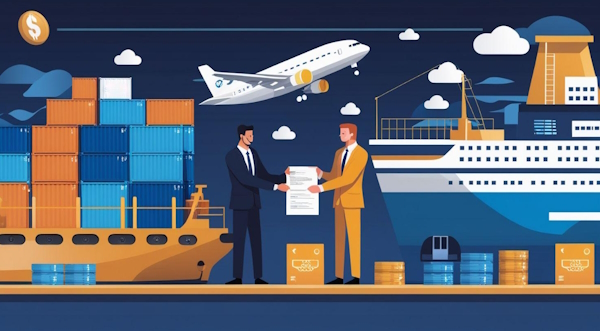Useful Service (Back to Job List)
 Click here to receive a daily email with new jobs from the 'Useful things to know...' category?
Click here to receive a daily email with new jobs from the 'Useful things to know...' category? (If you are already using this service but have been logged out, simply click here, re-enter your details and we'll email you a login link.)
Contact Information:
Published Content
Email yourself a copy of this job
Click here to see all adverts from Published Content
Click here to receive a daily email with new jobs from the 'Useful things to know...' category?
What Is Trade Finance?

Trade finance refers to a broad spectrum of financial instruments and services designed to facilitate international and domestic trade. These financial solutions encompass credit, cash flow financing, investments, and guarantees that help businesses mitigate risks associated with global transactions. Learn more about trade finance brokerage services here https://vtlcapital.com/services/trade-finance-brokerage/
At its core, trade finance ensures that companies maintain liquidity while safeguarding against payment delays or defaults. It acts as a bridge between buyers and sellers, offering structured financing options to enable seamless trade flows.
One of the most common examples is supplier credit, where a seller grants the buyer a specific period—typically 30, 90, or 180 days—to settle an invoice. Another prevalent method is a letter of credit (LC), in which a buyer’s bank guarantees payment once the seller delivers goods and presents the required documentation.
Trade finance solutions come in various forms, such as factoring, forfeiting, and customized lending arrangements tailored to business needs.
How Trade Finance Works
Financial institutions, primarily banks, play a pivotal role in trade finance by providing guarantees against default risks and offering credit facilities to exporters. By leveraging trade finance mechanisms, importers and exporters can focus on operations rather than being burdened by payment terms and risks.
Trade finance includes diverse instruments such as letters of credit, overdrafts, factoring, and freight payment solutions, all designed to streamline global transactions. Over time, these financial tools have significantly contributed to the expansion of international trade by ensuring smoother, safer, and more structured commercial exchanges. Ultimately, trade finance fosters economic cooperation and strengthens global business relationships.
Three Essential Forms of Trade Finance
Trade finance encompasses various products, but the three most widely utilized solutions include:
- Letters of Credit (LC): These are indispensable in global trade, guaranteeing payment to sellers once contract terms are fulfilled. Issued by the buyer’s bank, an LC ensures that funds are released only after goods are shipped and verified, protecting both parties.
- Bank Guarantees (BG): Unlike direct payments, a bank guarantee acts as a safety net. If the buyer defaults on a payment, the bank steps in to compensate the seller, minimizing risk exposure.
- Trade Credit: This arrangement allows buyers to defer payment until goods are resold or after an agreed period. By enabling businesses to manage cash flow effectively, trade credit is a crucial tool for both local and international trade.
Additional Trade Finance Solutions
Beyond these core instruments, businesses can leverage other trade finance tools, including:
Prepayment in Advance: A buyer provides payment before receiving goods or services, ensuring the seller has immediate working capital while assuming all risks tied to delivery.
- Working Capital Loans: These short-term loans help cover operational expenses, including raw materials and labor, allowing businesses to sustain and scale operations.
- Overdraft Facilities: Companies with an overdraft arrangement can withdraw beyond their account balance, ensuring continued financial flexibility.
- Factoring: Businesses can sell accounts receivable to a third party for immediate liquidity, bypassing long payment cycles.
- Forfaiting: Similar to factoring but focused on larger transactions, forfaiting allows exporters to sell their receivables at a discount in exchange for instant cash.
How Trade Finance Mitigates Risk
Trade finance serves as a protective measure for businesses engaged in cross-border transactions, addressing concerns like non-payment, political instability, and economic fluctuations. According to the World Trade Organization (WTO), trade finance underpins nearly 80-90% of global commerce, reinforcing its fundamental role in sustaining international markets.
By providing structured financial support, trade finance allows companies to confidently expand into new markets while ensuring timely payments and improved cash flow.
Key Benefits of Trade Finance
Engaging in trade finance offers businesses several advantages, including:
- Improved Cash Flow: Businesses can manage liquidity efficiently by using trade finance instruments that delay payments until after goods are delivered or sold.
- Reduced Financial Risks: Mitigating the risks associated with non-payment, trade finance safeguards companies from financial losses.
- Enhanced Security: With structured financial agreements in place, businesses can engage in international trade with greater confidence and reduced uncertainty.
- Higher Credit Availability: Letters of credit and bank guarantees enable companies to leverage financial resources more effectively, facilitating larger transactions.
- Tailored Financial Solutions: Businesses receive expert financial guidance to choose the most suitable instruments for their trading activities.
Types of Trade Finance Lenders
A variety of lenders offer trade finance solutions, each catering to different business needs:
- Banks: The most traditional trade finance providers, offering letters of credit, bank guarantees, and structured trade finance loans.
- Specialized Trade Finance Companies: These firms offer more flexible financing solutions, including factoring and supply chain finance.
- Export Credit Agencies (ECAs): Government-backed institutions that provide guarantees, loans, and insurance for export transactions.
- Alternative Lenders: Fintech companies and online platforms that provide faster, technology-driven financing solutions tailored to smaller businesses.
- Private Equity and Investment Funds: These firms fund large trade finance deals, often in high-risk markets or complex trade scenarios.
Steps to Secure Trade Finance
For businesses looking to access trade finance, the process typically involves:
- Determining the Right Trade Finance Solution: Companies must assess whether they need letters of credit, invoice financing, or supply chain finance.
- Selecting a Trade Finance Provider: Businesses should evaluate banks, specialized finance firms, or fintech platforms based on their specific needs.
- Preparing Essential Documents: Key documentation includes sales contracts, financial statements, business registration details, and trade history.
- Submitting the Application: Businesses must provide details on the trade deal, including payment terms, transaction value, and counterparties.
- Reviewing the Agreement: Before finalizing, companies should carefully examine the terms, including fees and repayment conditions.
- Utilizing the Finance: Once approved, the financing can be used to complete transactions, such as securing inventory or fulfilling purchase orders.
- Repayment and Relationship Building: Timely repayment builds trust with lenders, improving the chances of securing future financing on favorable terms.
Trade finance is the lifeblood of global commerce, enabling businesses to operate across borders with confidence. By leveraging trade finance solutions, companies can minimize financial risks, optimize cash flow, and expand into new markets. Whether through letters of credit, trade credit, or factoring, businesses have access to a wide range of financial instruments designed to make international transactions seamless and secure.
Be the First to Apply for Jobs Like This
Browse More Jobs from the "Useful things to know..." Category
Newsletter
To sign up up for GlosJobs weekly newsletter, please click here.







